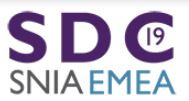To meet the increasingly higher demand on both capacity and performance in large cluster computing environments, the storage subsystem has evolved toward a modular and scalable design. The scale-out file system has emerged as one implementation of the trend, in addition to scale-out object and block storage solutions.
What are the key principles when architecting a scale-out file system? Find out on February 28th when the SNIA Networking Storage Forum (NSF) hosts The Scale-Out File System Architecture Overview, a live webcast where we will present an overview of scale-out file system architectures. This presentation will provide an introduction to scale-out-file systems and cover:
- General principles when architecting a scale-out file system storage solution
- Hardware and software design considerations for different workloads
- Storage challenges when serving a large number of compute nodes, e.g. name space consistency, distributed locking, data replication, etc.
- Use cases for scale-out file systems
- Common benchmark and performance analysis approaches










 SNIA Technical Council Co-Chair, on 2018 highlights and 2019 plans to educate and support this important technical community.
SNIA On Storage (SOS): In 2018, SNIA volunteers provided key resources and time supporting our storage developer community, a central focus for the Technical Council. What activities were the TC most pleased with in 2018?
Mark Carlson (MC): For the past several years we have been pushing SDC to expand globally. Starting with SDC India and this year adding SDC EMEA, we are reaching developers around the world now with educational content. Each year we get better and better talk proposals and the hard part is not being able to present more content. I always encourage developers to submit talks on their latest discoveries and architectures. Other developers want to hear about it.
SOS: There was a lot of good feedback on the content from SDC North America in 2018. What was your overall impression of this 21st SDC event?
MC: We had more folks than ever attending SDC 2018 and there was great energy in the sessions – particularly those hallway track ones. We had strong topics and speakers with 16 keynotes as well as the breakout sessions and BoFs. I enjoyed hearing about new architectures such as Computational Storage and composable infrastructure. And for those who missed attending in person, all 100 session presentations are available for download from the
SNIA Technical Council Co-Chair, on 2018 highlights and 2019 plans to educate and support this important technical community.
SNIA On Storage (SOS): In 2018, SNIA volunteers provided key resources and time supporting our storage developer community, a central focus for the Technical Council. What activities were the TC most pleased with in 2018?
Mark Carlson (MC): For the past several years we have been pushing SDC to expand globally. Starting with SDC India and this year adding SDC EMEA, we are reaching developers around the world now with educational content. Each year we get better and better talk proposals and the hard part is not being able to present more content. I always encourage developers to submit talks on their latest discoveries and architectures. Other developers want to hear about it.
SOS: There was a lot of good feedback on the content from SDC North America in 2018. What was your overall impression of this 21st SDC event?
MC: We had more folks than ever attending SDC 2018 and there was great energy in the sessions – particularly those hallway track ones. We had strong topics and speakers with 16 keynotes as well as the breakout sessions and BoFs. I enjoyed hearing about new architectures such as Computational Storage and composable infrastructure. And for those who missed attending in person, all 100 session presentations are available for download from the  SDC EMEA 2019 is also running an SMB Plugfest all week and has also scheduled an afternoon Technical Seminar on SMB. You can register and learn more at
SDC EMEA 2019 is also running an SMB Plugfest all week and has also scheduled an afternoon Technical Seminar on SMB. You can register and learn more at 
Leave a Reply